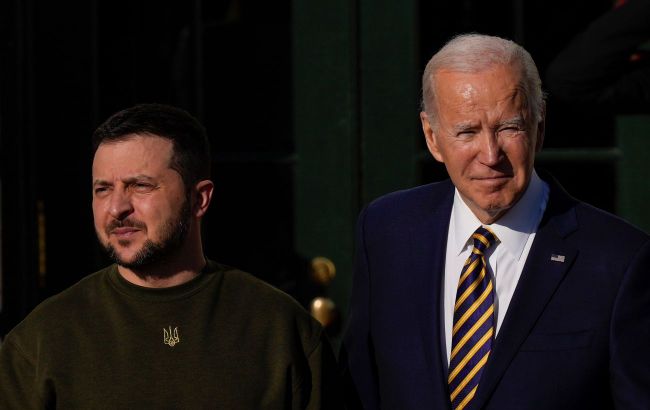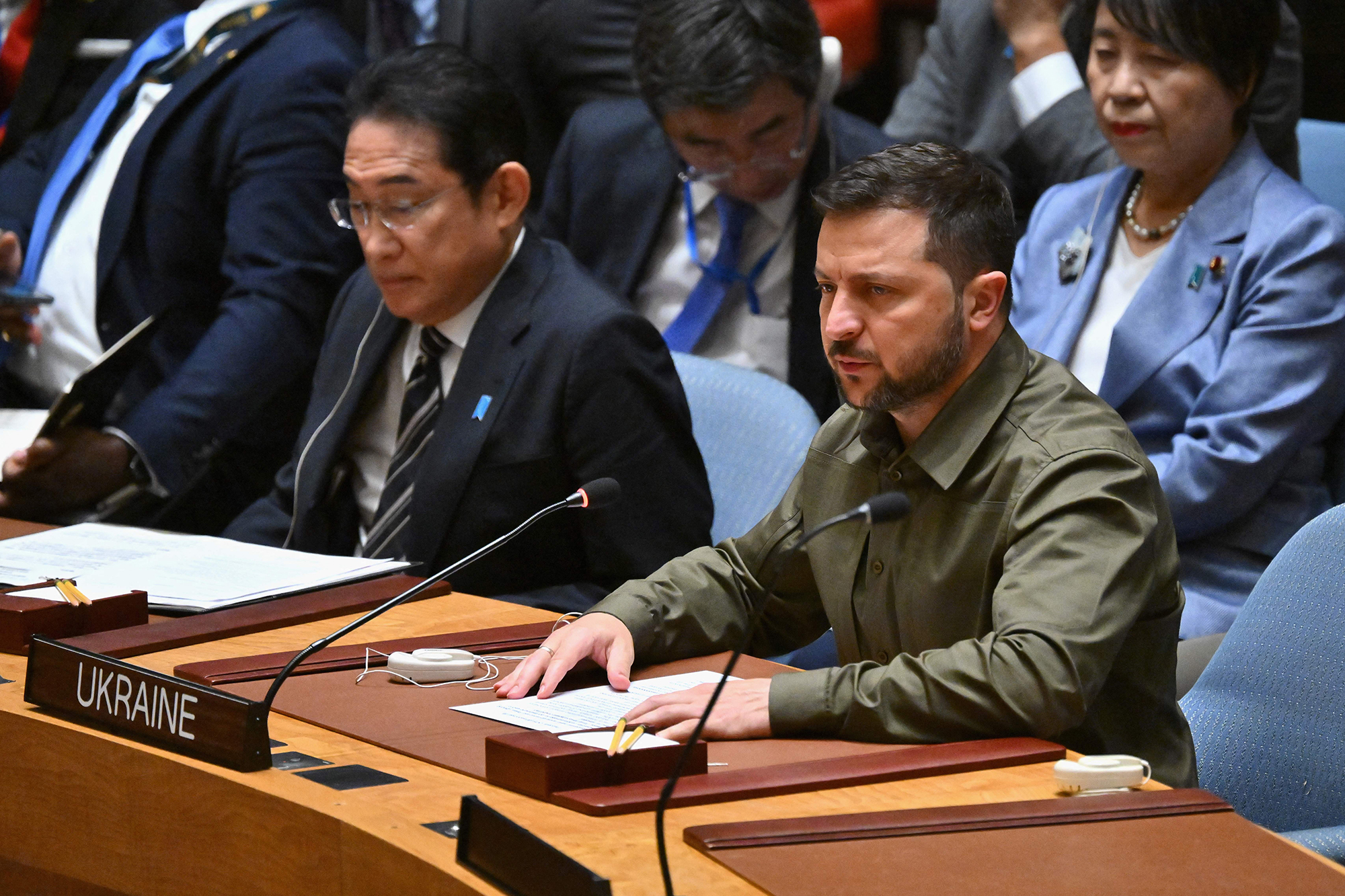US is on pause: Will Ukraine have enough weapons and money without American help?
 Ukrainian President Volodymyr Zelenskyy and US President Joe Biden (Getty Images)
Ukrainian President Volodymyr Zelenskyy and US President Joe Biden (Getty Images)
The U.S. Congress is still unable to decide on providing military aid to Ukraine. There is a risk that funds from Washington will not be allocated until at least the end of the election campaign in the United States. RBC-Ukraine provides details on how this will affect the military and economic capabilities of Ukraine.
The material includes comments from Oleksandr Kovalenko, military-political expert of the information resistance group, comments from representatives of the Ministry of Finance, RBC-Ukraine interlocutors in the government, as well as information from open sources.
In the first one-and-a-half years since the start of the full-scale war, Ukraine has become accustomed to the fact that Western military aid is supplied regularly and without major disruptions. Of course, there were constant disputes over specific categories of weapons, such as tanks, long-range missiles, or aircraft, which had to be argued for months. But the fact of assistance from the West was never questioned, it was only about its volumes and pace.
However, significant issues started to arise in the fall of last year for Ukraine's number one ally, the United States, where the presidential campaign was gaining momentum. Due to the stance of the Republicans, or more precisely, the wing of the party oriented towards Donald Trump, approval of the next aid package has been stalled for several months.
Initially, there was talk of linking assistance to Ukraine (as well as Taiwan and Israel, which are included in one budget package with Ukraine) to immigration reform and strengthening the American border with Mexico. It took several weeks to agree on the relevant deal.

President Volodymyr Zelenskyy at a meeting of the US Congress (photo: Getty Images)
However, it turned out that Trump and his supporters categorically rejected the deal. The obvious reason for this is that Trump's headquarters made immigration the main theme of the presidential campaign. Therefore, its resolution is not in their pragmatic interests now. After all, if the migration issue is removed from the agenda, the pre-election strategy will have to be rewritten again.
The issue of assisting Ukraine is currently under consideration by the American Senate, with a decisive vote expected next week. But even if the upper house of Congress approves it, which is increasingly doubtful, the consent of the House of Representatives, where Republicans make up the majority, will be needed. And their leader and future presidential candidate Trump increasingly openly indicates that he opposes providing any assistance to Ukraine as such. Moreover, on February 10, at a pre-election rally in South Carolina, Trump said that he would encourage Russia to "do what it wants" until NATO countries "pay their bills." Regarding Trump's general mood, the words of Republican congressmen who visited Kyiv on February 9 and declared their support for Ukraine look unconvincing.
Therefore, there is a risk that at least until the beginning of next year, when the elected president of the United States is sworn in and a new composition of the House of Representatives is formed, Ukrainian assistance cannot be relied upon.
In 2022-2023, such a situation would have been equivalent to a catastrophe for Ukraine, as many other Western allies of Kyiv always followed Washington in their actions. And even key European countries preferred not to rush events if signals were not coming from there about the need to actively help Ukraine.
By the end of 2023, the situation began to change: Europe increasingly began to take over the leading role in assisting Ukraine from the United States. This includes the leading economy of the European Union, Germany, whose leader Olaf Scholz has undergone a remarkable transformation over the past months from an extremely cautious politician regarding Ukraine to a true leader of the pro-Ukrainian Western coalition.
However, as RBC-Ukraine interlocutors in the government admit, finding a full-fledged alternative to the $60 billion aid package proposed by Joe Biden is hardly possible, as this is too large a sum. However, equating the absence of American assistance with Ukraine's inevitable catastrophe would also be an exaggeration.
Year-long blind defense
The United States is one of the main suppliers of various weapons to Ukraine. This includes armored vehicles M1 Abrams tanks, armored personnel carriers, as well as long-range strike systems, self-propelled artillery units, and modern air defense systems, which allow Ukrainian forces to successfully repel mass missile and drone attacks. By the way, ammunition for air defense systems is also included in the aid package currently being discussed in Congress.
Even more importantly, the States supply the Armed Forces of Ukraine with ammunition, and they are consumables on the front line, so they are needed in large quantities and regularly. Ukraine experiences a constant shortage of them, notes military-political expert of the Information Resistance group Oleksandr Kovalenko.
"Proportional distribution of ammunition during defense is very important, especially the artillery component. Today, we have an acute shortage of ammunition and austerity in artillery rounds. And this negatively affects our capabilities. I'm not talking about offensive actions. Not even about defense," the expert notes in a comment to RBC-Ukraine.
Today, Ukraine's military-industrial complex is undoubtedly much more powerful than before the start of the full-scale war, but it is still unable to independently meet the needs of the Armed Forces. Ukrainian manufacturers are focusing on drones, producing various types of UAVs in large quantities. But drones alone will not be enough to maintain defense, let alone go on the offensive. Either way, the Ukrainian military-industrial complex will not be able to cover the needs of the army.
If Congress does not come to a positive decision for Kyiv and postpones this issue until the presidential elections, the Ukrainian military will have to go into a blind defense. But it will be difficult to maintain it equally effectively for a whole year. At some point, the capabilities of the Armed Forces of Ukraine will begin to wane and there will be a critical shortage of weapons and ammunition.
"We will gradually cede various sectors and positions. The defense forces of Ukraine will have to step back gradually over time in certain directions, regions, and areas, unfortunately," Kovalenko says.

Ukrainian military (photo: General Staff)
No one can accurately predict when the stocks of military equipment and ammunition will run out, but even half a year of stagnation for any army is a significant period of time. In the West, it is argued that such a pause could lead to irreversible consequences. And in a year, if assistance is eventually provided, it will be difficult to rebuild the Ukrainian army. Analysts note that certain weapon systems will begin to feel the shortage sooner than expected. For example, to ensure that the air defense continues to cope with missile attacks, it needs to be replenished as early as March.
Russia, which also faced a deficit of key positions at a certain point, has managed to mend relations with similar outcast countries and now faces no critical issues in terms of armament. Additionally, Russia has been able to restructure its military-industrial complex, providing the army with equipment that may not be the most modern, but still effective, and, more importantly, with ammunition.
While the Ukrainian military-industrial complex cannot fully meet the needs of the army, it is crucial for Kyiv to receive assistance from allies. Besides the United States, the European Union can be considered the second main partner. Apart from the agreed economic assistance of 50 billion euros, the EU is also contemplating how to strengthen its own military capabilities.
In two years of a major war, European partners have gradually but surely become more active. While previously the European Union primarily assisted in the humanitarian sphere, today there is a focus on the military component, with an increase in the production of military equipment since the end of 2023. However, it seems Europeans would pursue this path even if the US were to approve a military aid package for Ukraine. They won't be able to fully fill the "American niche," as the EU lacks sufficient capabilities.
This sentiment is echoed by some EU countries. For instance, during his recent visit to Washington, German Chancellor Olaf Scholz stated that Germany alone would not be able to support Ukraine, hence the issue of the military package lies with the United States. Obviously, understanding the extent of the needs of the Ukrainian Armed Forces, other partners of Kyiv are also voicing similar sentiments. Just a few days ago, Prime Minister of Poland Donald Tusk criticized Americans.
"Dear Republican Senators of America. Ronald Reagan, who helped millions of us to win back our freedom and independence, must be turning in his grave today. Shame on you?" he wrote.
Clearly, Ukrainian diplomats will need to establish cooperation with non-obvious partners this year. For example, with Asia, says Oleksandr Kovalenko from RBC-Ukraine. Japan has already agreed to cover some of Ukraine's needs by providing Patriot SAM missiles.
"The Asian region can not only help in this matter but also completely replace the US in terms of ammunition for about a year," the expert says.

Zelenskyy and Prime Minister Fumio Kishida (photo: Getty Images)
Additionally, Ukraine is cooperating with Latin America and attempting to establish contacts with African countries. Last year, Morocco agreed to transfer Soviet T-72 tanks to Ukraine. Some African countries also possess Soviet-era military equipment. In other words, 2024 could be the year when Kyiv receives not substantial but still necessary assistance from individual states.
"We are seeking partners in countries we did not expect to find them in before. Thus, we can replace this assistance precisely at a time when the U.S. political battles are not stabilizing," the expert added.
Nevertheless, neither European assistance nor the assistance of situational allies will cover Ukraine's needs. Moreover, the current situation in the U.S. Congress raises doubts about the reliability of the States as a partner. While Europe perceives this situation as a signal to strengthen its own defense industry, aggressor countries, whose interests have always been military conflicts in various parts of the world, are particularly attentive to the crisis in the U.S. Congress today.
Economy without the U.S.
Another crucial component of Western assistance for Ukraine, aside from military aid, is finance. Ukraine needs $41 billion from external donors to finance its state expenses in 2024. From the EU, Ukraine expects to receive 18 billion euros under the Ukraine Facility program in 2024. The decision to allocate these funds has already been made, a four-year package of macro-financial assistance worth 50 billion euros has been approved. It remains to agree on the terms of financing and the amount for the current year.
So far, the EU has only agreed to 9 billion euros, as confirmed by sources of RBC-Ukraine in the government. In a situation where the resolution of the funding issue from the U.S. is delayed, there are more arguments to persuade the EU to allocate more money in 2024, as all partners understand the importance of financial support for Ukraine. The final amount of funds from the EU this year will be known at the end of February after the European Parliament approves the Ukraine Facility regulation.
The American aid package includes over $60 billion, with 7.9 billion directly allocated to the Ukrainian budget, whereas earlier versions of the project mentioned $11.8 billion. The rest of the amount is intended for military and related expenses.
However, without this $8 billion from the US, Ukraine will find it extremely difficult to survive this year, even if an agreement is reached to increase funding from the EU and other partners, including Belgium, Denmark, South Korea, Latvia, Lithuania, the Netherlands, and Japan.
"Ukraine needs the support of the European Union, but Europe cannot replace the US," said EU chief diplomat Joseph Borrell in October. Similar messages have been regularly voiced by representatives of the European Union in recent weeks, against the backdrop of pessimistic news from across the ocean.
Over two years of war, the U.S. has financed Ukraine's budget by nearly $23 billion - around 84% of the EU assistance volume and more than a third of the total amount of budget support from all partners.
At the outset of the year, Ukraine seems to be managing its budgetary expenditures independently, without external injections. This has been made possible by the leftover funds from international aid received last year and an increase in revenues through tax and customs collections. According to Danylo Hetmantsev, the head of the Tax Committee of the Rada (Ukrainian government - ed.), revenue collection has increased due to de-shadowing.
"Last year, the budget was executed with the help of grants. This time, we have collected it ourselves. Year by year, there's a plus of 24 billion through taxes, plus 20 billion through customs... This source is the sole internal resource. It's a significant reserve because every penny goes to the army. However, this resource cannot replace the assistance we receive from partners," said Hetmantsev.
Under the current circumstances, without external support, Ukraine will be able to manage budget financing smoothly only until the end of February. After that, if the issue of external inflows remains unresolved, they will have to activate Plan B.
Plan B was initiated towards the end of last year when there was a delay in the disbursement of funds from the USA due to the reallocation of individual income tax to military expenditures. Currently, almost all public comments regarding the next steps of this plan are being declined: both by deputies of relevant committees and government officials.
Meanwhile, government representatives plan to coordinate with the IMF (International Monetary Fund - ed.) on a contingency plan in case of delays in external budget financing. This plan may involve increased borrowing from the domestic market, expenditure cuts, and tax hikes.
The Ministry of Finance remains optimistic, believing that a decision regarding U.S. funding should be forthcoming, as partners understand the consequences of prolonged assistance delays.
"We maintain regular dialogue with colleagues from the U.S. Treasury, they understand our needs and situation very well. And they assure us that a decision will be made – it's just a matter of time," said the Ministry of Finance in a comment to RBC-Ukraine.
In case of the absence of a decision from the U.S., the Ministry of Finance is actively seeking additional funding sources from partners.
Sources within several agencies have indicated that there are currently no plans for any radical steps under Plan B, such as emissions or postponing the pension indexation scheduled for March. "There's no discussion of this at the moment," said one of the RBC-Ukraine's interlocutors.
Efforts are underway to find additional funds through internal reserves, including increasing the dividend percentage for allocation to the state budget by state-owned companies. Negotiations regarding increased financial support from certain partner countries of Ukraine will be concluded shortly.
There have been no significant fluctuations in the currency market so far. The National Bank is maintaining the exchange rate within certain bounds, supported by foreign reserves. While these reserves have begun to decline, they are far from critical levels. They decreased by 2 billion in January: 38.5 as of February 1 compared to 40.5 as of January 1.
Thus, according to government sources, February will pass without significant shocks for Ukraine. In March, funds from the Ukraine Facility are expected to start flowing – the first tranche of 4.5 billion euros is expected to be disbursed immediately after the program is approved.
However, it should be remembered that the U.S. is considering the REPO Act, which would transfer frozen Russian assets to Ukraine. RBC-Ukraine reported on this in January. Its adoption would allow the transfer of around 8 billion dollars to Ukraine at the discretion of the U.S. president.
"We very much hope that once the issue of budgetary assistance, which is very relevant, is resolved, the confiscation law (REPO – ed.) will be quickly passed, as it enjoys broad support," said Ukraine's ambassador to the U.S., Oksana Markarova. According to her, this will not only increase support for Ukraine but also serve as an example for other countries where Russian assets are frozen. However, it is crucial that the confiscated funds do not become an alternative form of support for Ukraine. RBC-Ukraine has already reported that partners are considering this option in the event of assistance delays.
***
How Ukraine will fare a year without assistance from its number one ally is still a hypothetical question. In Kyiv, hopes continue to be pinned on Plan A, which is under consideration by forces supporting Ukraine in the U.S. Congress. At least publicly, no representatives of the U.S. establishment have contemplated Plan B. However, Ukrainian diplomats, as in the past two years, continue actively seeking other allies. If Congress fails to make a decision favorable to Kyiv, it's evident that the Ukrainian military will have to dig in, and allies will have to make important, and perhaps unpopular, decisions for their defense industries and invest much more than before.

